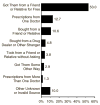Addiction to prescription opioids: characteristics of the emerging epidemic and treatment with buprenorphine
- PMID: 18837640
- PMCID: PMC4687728
- DOI: 10.1037/a0013637
Addiction to prescription opioids: characteristics of the emerging epidemic and treatment with buprenorphine
Abstract
Dependence on and abuse of prescription opioid drugs is now a major health problem, with initiation of prescription opioid abuse exceeding cocaine in young people. Coincident with the emergence of abuse and dependence on prescription opioids, there has been an increased emphasis on the treatment of pain. Pain is now the "5th vital sign" and physicians face disciplinary action for failure to adequately relieve pain. Thus, physicians are whipsawed between the imperative to treat pain with opioids and the fear of producing addiction in some patients. In this article, the authors characterize the emerging epidemic of prescription opioid abuse, discuss the utility of buprenorphine in the treatment of addiction to prescription opioids, and present illustrative case histories of successful treatment with buprenorphine.
Copyright (c) 2008 APA, all rights reserved.
Figures



References
-
- Ballantyne JC, LaForge KS. Opioid dependence and addiction during opioid treatment of chronic pain. Pain. 2007;129:235–255. - PubMed
-
- Becker WC, Fiellin DA, Merrill JO, Schulman B, Finkelstein R, Olsen Y, et al. Opioid use disorder in the United States: insurance status and treatment access. Drug and Alcohol Dependence. 2008;94:207–213. - PubMed
-
- Becker WC, Sullivan LE, Tetrault JM, Desai RA, Fiellen DA, et al. Non-medical use, abuse and dependence on prescription opioids among US adults: Psychiatric, medical and substance use correlates. Drug and Alcohol Dependence. 2008;94:38–47. - PubMed

